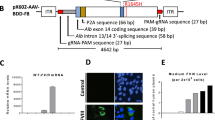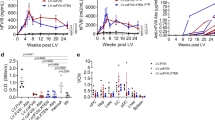Abstract
A dual-vector system was explored for the delivery of the coagulation factor VIII gene, using intein-mediated protein trans-splicing as a means to produce intact functional factor VIII post-translationally. A pair of eukaryotic expression vectors, expressing Ssp DnaB intein-fused heavy and light chain genes of B-domain deleted factor VIII (BDD-FVIII), was constructed. With transient co-transfection of the two vectors into 293 and COS-7 cells, the culture supernatants contained (137±23) and (109±22) ng mL−1 spliced BDD-FVIII antigen with an activity of (1.05±0.16) and (0.79±0.23) IU mL−1 for 293 and COS-7 cells, respectively. The spliced BDD-FVIII was also detected in supernatants from a mixture of cells transfected with inteinfused heavy and light chain genes. The spliced BDD-FVIII protein bands from cell lysates were visualized by Western blotting. The data demonstrated that intein could be used to transfer the split factor VIII gene and provided valuable information on factor VIII gene delivery by dual-adeno-associated virus in hemophilia A gene therapy.
Similar content being viewed by others
References
Saleh L, Perler F B. Protein splicing in cis and in trans. Chem Rec, 2006, 6: 183–193 10.1002/tcr.20082, 16900466, 1:CAS:528:DC%2BD28XptlymsLs%3D
Wu H, Xu M Q, Liu X Q. Protein trans-splicing and functional mini-inteins of a cyanobacterial dnaB intein. Biochim Biophys Acta, 1998, 1387: 422–432 9748659, 1:CAS:528:DyaK1cXlsl2gt7o%3D
Wu H, Hu Z, Liu X Q. Protein trans-splicing by a split intein encoded in a split DnaE gene of Synechocystis sp. PCC6803. Proc Natl Acad Sci USA, 1998, 95: 9226–9231 10.1073/pnas.95.16.9226, 1:CAS:528:DyaK1cXltlCmtbw%3D
Xu M Q, Perler F B. The mechanism of protein splicing and its modulation by mutation. EMBO J, 1996, 15: 5146–5153 8895558, 1:CAS:528:DyaK28XmsVeitbk%3D
Gnatenko D V, Saneko E L, Jesty J, et al. Human factor VIII can be packaged and functionally expressed in an adeno-associated virus background: applicability to haemophilia A gene therapy. Br J Haematol, 1999, 104: 27–36 10.1046/j.1365-2141.1999.01137.x, 10027708, 1:CAS:528:DyaK1MXhsF2lt7w%3D
Sarkar R, Tetreault R, Gao G, et al. Total correction of hemophilia A mice with canine FVIII using an AAV 8 serotype. Blood, 2004, 103: 1253–1260 10.1182/blood-2003-08-2954, 14551134, 1:CAS:528:DC%2BD2cXhsVSlt7Y%3D
Sharma S S, Chong S, Harcum S W. Intein-mediated protein purification of fusion proteins expressed under high-cell density conditions in E. coli. J Biotechnol, 2006, 125: 48–56 10.1016/j.jbiotec.2006.01.018, 16546284, 1:CAS:528:DC%2BD28XntlCks7Y%3D
Williams N K, Prosselkov P, Liepinsh E, et al. In vivo protein cyclization promoted by a circularly permuted Synechocystis sp. PCC6803 DnaB mini-intein. J Biol Chem, 2002, 277: 7790–7798 10.1074/jbc.M110303200, 11742000, 1:CAS:528:DC%2BD38XitFynu78%3D
Ludwig C, Schwarzer D, Mootz H D. Interaction studies and alanine scanning analysis of a semi-synthetic split intein reveal thiazoline ring formation from an intermediate of the protein splicing reaction. J Biol Chem, 2008, 283: 25264–25272 10.1074/jbc.M802972200, 18625708, 1:CAS:528:DC%2BD1cXhtVyisLrO
Kaufman R J. Advances toward gene therapy for hemophilia at the millennium. Hum Gene Ther, 1999, 10: 2091–2107 10.1089/10430349950017095, 10498242, 1:CAS:528:DyaK1MXlvVGrsbc%3D
Murphy S L, High K A. Gene therapy for haemophilia. Br J Haematol, 2008, 140: 479–487 10.1111/j.1365-2141.2007.06942.x, 18275425, 1:CAS:528:DC%2BD1cXkt1ersLs%3D
Scallan C D, Liu T, Parker A E, et al. Phenotypic correction of a mouse model of hemophilia A using AAV2 vectors encoding the heavy and light chains of FVIII. Blood, 2003, 102: 3919–3926 10.1182/blood-2003-01-0222, 12893764, 1:CAS:528:DC%2BD3sXpsFamurc%3D
Burton M, Nakai H, Colosi P, et al. Coexpression of factor VIII heavy and light chain adeno-associated viral vectors produces biologically active protein. Proc Natl Acad Sci USA, 1999, 96: 12725–12730 10.1073/pnas.96.22.12725, 10535990, 1:CAS:528:DyaK1MXnt1yqsb8%3D
Mah C, Sarkar R, Zolotukhin I, et al. Dual vectors expressing murine factor VIII result in sustained correction of hemophilia A mice. Hum Gene Ther, 2003, 14: 143–152 10.1089/104303403321070838, 12614565, 1:CAS:528:DC%2BD3sXhtlyjtro%3D
Zhang K, Shen X, Wu J, et al. Endoplasmic reticulum stress activates cleavage of CREBH to induce a systemic inflammatory response. Cell, 2006, 124: 587–599 10.1016/j.cell.2005.11.040, 16469704, 1:CAS:528:DC%2BD28Xhslaqs7Y%3D
Chao H, Sun L, Bruce A, et al. Expression of human factor VIII by splicing between dimerized AAV vectors. Mol Ther, 2002, 5: 716–722 10.1006/mthe.2002.0607, 12027555, 1:CAS:528:DC%2BD38XktFGjtbs%3D
Sun L, Li J, Xiao X. Overcoming adeno-associated virus vector size limitation through viral DNA heterodimerization. Nat Med, 2000, 6: 599–602 10.1038/75087, 10802720, 1:CAS:528:DC%2BD3cXjtFynsLo%3D
Yan Z, Zhang Y, Duan D, et al. Trans-splicing vectors expand the utility of adeno-associated virus for gene therapy. Proc Natl Acad Sci USA, 2000, 97: 6716–6721 10.1073/pnas.97.12.6716, 10841568, 1:CAS:528:DC%2BD3cXktFait7g%3D
Sarkar R, Xiao W, Kazazian H H Jr. A single adeno-associated virus (AAV)-murine factor VIII vector partially corrects the hemophilia A phenotype. J Thromb Haemost, 2003, 1: 220–226 10.1046/j.1538-7836.2003.00096.x, 12871492, 1:CAS:528:DC%2BD2cXktFenu7o%3D
Ishiwata A, Mimuro J, Kashiwakura Y, et al. Phenotype correction of hemophilia A mice with adeno-associated virus vectors carrying the B domain-deleted canine factor VIII gene. Thromb Res, 2006, 118: 627–635 10.1016/j.thromres.2005.11.006, 16371232, 1:CAS:528:DC%2BD28XpvV2lsLs%3D
Scallan C D, Lillicrap D, Jiang H, et al. Sustained phenotypic correction of canine hemophilia A using an adeno-associated viral vector. Blood, 2003, 102: 2031–2037 10.1182/blood-2003-01-0292, 12738670, 1:CAS:528:DC%2BD3sXntlKku7g%3D
Chen L X, Zhu F X, Li J, et al. The enhancing effects of the light chain on heavy chain secretion in split delivery of factor VIII gene. Mol Ther, 2007, 15: 1856–1862 10.1038/sj.mt.6300268, 17653101, 1:CAS:528:DC%2BD2sXhtVGmtrnF
Gao Y J, Zhao C K, Yin Q, et al. Split-intein mediated high efficient cellular fusion of transcription factor. Sci China Ser C-Life Sci, 2008, 38: 714–721
Author information
Authors and Affiliations
Corresponding author
Rights and permissions
About this article
Cite this article
Zhu, F., Liu, Z., Chi, X. et al. Protein trans-splicing based dual-vector delivery of the coagulation factor VIII gene. Sci. China Life Sci. 53, 683–689 (2010). https://doi.org/10.1007/s11427-010-4011-7
Received:
Accepted:
Published:
Issue Date:
DOI: https://doi.org/10.1007/s11427-010-4011-7




